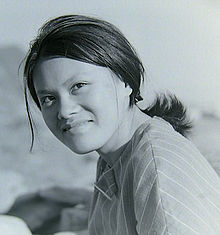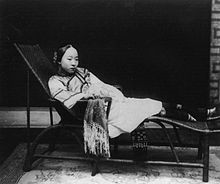- Chinese ideals of female beauty
-
In Chinese contemporary popular culture, various aspects of female beauty ideal exists.
Contents
History
The emphasis of both Taoist and Confucian notions of female beauty on the relationship between inner and outer beauty has influenced the creation of Chinese female beauty ideal.[clarification needed] Outer beauty was thought to represent virtuousness, talent, and other positive characteristics.
For example, in Taoist thought, women with manly voices make poor sexual partners, because this trait suggests an excess of ch'i that inhibits the attainment of sexual harmony. In her article “Female Bodily Aesthetics, Politics, and Feminine Ideals of Beauty,” Eva Kit Wah Man articulates how Confucianism and Taoism played essential roles in the creation of Chinese beauty ideals: “In the Chinese tradition, as in other cultures, both the external sexual and inner moral dimensions determine the beauty of a woman…The notion of female beauty comes from both (Taoism and Confucianism).” "Femininity" does not refer to part of dichotomy between mind and body in Chinese philosophy neither because there is no such dichotomy in Chinese philosophy.[1] Thus, historically, the religious influences on Chinese beauty ideals tied outer beauty closely to inner beauty.
Modern Chinese society is highly affected by Western capitalist and Marxist thoughts. The Chinese would not describe themselves as a completely Capitalist country, nor a purely Marxist country. They tend to ignore this type of question about the essence of its political position, and develop their economy, politics, culture and feminism in their own way. They call themselves a socialist market economy with Chinese characteristics. The rise of Chinese feminist development is highly influenced by the idea that since the early 19th century, the “new “ China and its government claimed that they are the one who would save the Chinese woman from the “old society” and set women’s minds free (Chun, 2008). An article published in the widely circulated journal Dushu uses an earlier nativist satire to argue that women themselves voluntarily desired the beauty of small feet right into the first decades of the twentieth century, despite the elite, male-dominated discourse of liberation and equality that assailed the practice.[2] . During that time, Chinese women seem to have been treated equally. The Chinese government ended the practice of foot binding, and women can do any job they want—even heavy-duty jobs in factories. The “Iron Woman” as an honorary title and very positive woman image was created by the Chinese government and shaped both Chinese men and women’s ideologies.
Hair
Advertising offers insight into the Chinese conception of beautiful hair. As of 2004, the consumption of cosmetics and hair products in China had grown over the past twenty years from 25 million US dollars to 6 billion US dollars, brands are eager to advertise their products to the growing market.[3]
Contemporary sinophone shampoo commercials aimed at female consumers typically portray the same beauty ideal when it comes to hair: long, shiny, dark, and sleek. The thirty second clips usually feature a solitary model with a thick, glistening mane. Engaged in any activity – simply lounging around the house or, as in the case of one commercial, jumping out of an airplane[citation needed] – her hair is in constant motion. The commercials characterize the model’s animated and lively hair as strong, shiny, long, and soft. Often, a male gaze on the model sexualizes and eroticizes the hairstyle. Sometimes a male character appears, usually to approve of or admire the gorgeous hair the product had created, but often the male gaze is implied.
See also
Notes
- ^ Kit Wah Man, Eva (2000), "Female Bodily Aesthetics, Politics, and Feminine Ideals of Beauty in China", Beauty Matters, Indiana Univ Pr, pp. 169–96, http://books.google.co.uk/books?id=y7yjRlwg8agC&pg=PA169
- ^ Chun, Lin (2008). On Feminism and China: Foot-Binding as an Aesthetic, History and Dialogue. New York. pp. 23–30. http://www.asianetwork.org/exchange/2008-spring/anex2008-spring-lin.pdf.
- ^ "Chinese New Year: cosmetics consumption in China has grown in the last 20 years from around RMB 200 million (US$25 million) to more than US$6 billion.(Trade Routes)." http://www.highbeam.com/doc/1G1-115758625.html High Beam Research. 1 Mar. 2004. 20 Apr. 2009
Categories:
Wikimedia Foundation. 2010.


